The content of the article
A pregnant woman closer to birth begins a "nesting syndrome." She is actively starting to prepare for her upcoming life with her unborn baby. Curtains are washed, floors are washed under sofas and in other places where a person’s foot usually does not step. It comes to the future crib of the child. A woman tries to make or buy beautiful sides in a crib, takes care of blankets and pillows. But any mother knows that the main thing is a mattress. The mood and future health of the crumbs depends on it. An incorrectly chosen mattress can lead to problems with the spine, poor rest and, as a result, poor mood. In order for the baby to be healthy, cheerful and cheerful, the mattress must be chosen correctly.
What should be a children's mattress
To make the sleep of a newborn baby comfortable, long and deep, the mattress must meet certain criteria.
- Safe. This is the first rule that applies to the mattress. Filler should consist only of environmentally friendly materials. It is very important that the mattress filler is not food for germs, ticks and bugs. Many manufacturers make special antibacterial treatment to protect the insides of the mattress from various insects.
- Hypoallergenic. When choosing a filler, you need to be as careful as possible - some components (especially natural ones) can cause an allergic reaction in a child. For example, allergies can occur to swan fluff or camel hair. It is clear that the mattress for the newborn is prepared in advance. When you leave your child to sleep for the first time on a new mattress, be sure to monitor his reaction. If redness, itching appears on the skin, if the baby begins to cough - this may cause an allergic reaction.
- The right size. It is very important to choose the right mattress size. If the mattress is larger, it will rise with tubercles, which makes the surface uneven. On such a mattress, the baby cannot sleep. If the mattress is small, a gap appears between the wall of the crib and the edge of the mattress itself. The baby's legs may fall into this gap when he learns to stand up. It is very important to choose the right height of the mattress. Usually children's mattresses do not exceed 6 centimeters in height. If the mattress is higher, the baby may roll over and fall out of the crib when it starts to rise to its legs.
- Hard. The spine of an adult has two physiological bends - in the lumbar region and in the neck. The spine of a newborn baby is almost flat, without bends. To help the baby in the formation of the correct posture, you need to choose the right things that will surround him. A good orthopedic mattress is the basis of the even back of the unborn child. The mattress should be moderately hard so that certain zones are not forced under the mass of the tiny baby. Orthopedists around the world talk about the necessary rigidity of the mattress for newborns and children of the first year of life. This contributes to the formation of a beautiful posture. In addition, a soft mattress can be dangerous - when the baby is lying on his stomach and does not know how to raise his head, the mattress can lead to suffocation.
- Breathable. It is very important that the mattress can be dried. After all, the baby can be described if it was without an diaper or on top there was no impenetrable mattress cover. In any case, this is a child and an incident can happen at any time. In addition, breathability allows the mattress to “breathe”, which prevents the appearance of insects and dampness inside the filler. In order for the mattress to be “breathable”, it is important to consider not only the filler material, but also the naturalness of the top fabric coating.
These are the main criteria by which you need to choose a mattress. But what should be inside a quality mattress? Which filler to choose so that the newborn is comfortable and safe?
Filling for mattresses
When choosing a good mattress for a child, it is very important to pay attention to its contents. The mattress can be spring and springless. Spring mattresses, in turn, are divided into dependent and independent spring blocks. Springless mattresses can be filled with various natural or artificial materials. Let's talk about each type of mattress in more detail.
- Mattress with dependent springs. This is the so-called Bonnel mattress manufacturing technology. It is most popular due to the relative cheapness of the product. Bonnel - these are interconnected springs, when pressed one, adjacent springs are compressed. Thanks to this, the mattress repeats the anatomy of the human body worse, but withstands heavy loads and weights. Over time, such a mattress quickly deteriorates, as the baby grows and begins to walk on the mattress with his feet. From this, the spring blocks become unusable. If you decide to buy just such a mattress, pay attention to the diameter of the springs - the smaller they are, the longer the mattress will last.
- Independent spring blocks. The design of such a mattress involves the use of independent springs. That is, each spring is surrounded by a special cover and fixed in a specific place. The springs are not interconnected, therefore, when pressed on one, the neighboring ones do not compress. This makes the mattress completely orthopedic - it perfectly repeats the bends of the human body. For a newborn, you should choose a mattress with independent spring blocks of medium or high stiffness so that the child’s skeleton is formed correctly. Among the additional advantages of such a mattress can be called its noiselessness - the springs do not creak when changing the position of the body. In addition, the spine on such a mattress really relaxes and completely relaxes. Among the disadvantages of independent spring blocks are the high price of the product, the large weight of the mattress and the relatively high height. The child can subsequently fall out of the crib with such a high mattress.
- Coconut fiber or coir. These are coconut fibers that are commonly sold with latex. That is, the mattress turns out to be two-layer - one side is latex, the other is coir. To check the quality of coconut fiber, you need to ask the seller for a certificate of conformity for the product. It is very important to feel the cut coconut fiber, if it crumbles, the mattress is of poor quality. In this case, fine coconut dust can lead to allergies in the child. In addition, it is worth smelling the mattress - if it smells of rubber, then the latex is synthetic. A high-quality coconut fiber mattress is very good for a baby - it has sufficient rigidity, is well ventilated, dries quickly, does not cause allergic reactions. In addition, coconut fibers do not absorb moisture, do not swell and do not rot.
- Latex. Latex can be natural or artificial. Natural latex is made from the sap of certain trees, it’s just rubber. However, pure rubber is afraid of sunlight and high temperatures, so additional components are added to its composition, which make the rubber more wear-resistant. A good latex mattress contains up to 60% natural rubber. Such a mattress will last you a very long time, it is elastic, comfortable and environmentally friendly. Insects and germs will not start in such material. Usually inside the latex mattress there are special tunnels for ventilation. However, it is very important to choose natural latex when buying, and not its synthetic (artificial) substitute, which is also called highly elastic polyurethane foam.In principle, this is a fairly worthy analogue of natural material, repeats the human anatomy well, in addition, such a mattress is much cheaper than real latex. However, for young children, the material is not suitable - artificial rubber can become a source of an allergic reaction.
- Vata. In recent years, cotton filling began to recede into the background, although cotton mattresses can often be found, especially in houses with an old interior. It is proved that cotton wool is an obsolete material, it rolls into lumps, which creates irregularities on the surface of the mattress. In addition, harmful microorganisms can live in cotton wool, cotton wool absorbs damp, poorly dried, etc.
These are the most common types of fillers for mattresses, their advantages and benefits. Whatever mattress you buy, you need to know a few more nuances regarding its operation.
How to care for a mattress
When preparing a crib for an unborn baby, it is important to understand that in addition to the mattress, you need to provide a berth with additional accessories. It is best to wrap the walls of the crib with special soft sides - they will protect the baby from injury and bumps on hard rods of the crib. It is very important for a baby of the first year of life not to use a pillow. All orthopedists insist that the use of a pillow can distort the spine and the child will suffer from incorrect physiological bending of the cervical spine. Also, the baby should buy a warm blanket made of natural fabrics, which will protect him from the cold. It is very important to lay a mattress cover, which will soften a rather hard mattress, make the bed more comfortable and cozy. Choose a waterproof mattress cover so that in case of an “accident” the mattress does not get wet. After all, drying a mattress cover is much simpler and faster than the mattress itself.
Caring for a mattress is not difficult. Once every three months, you need to turn it over in order to avoid staleness and the formation of tubercles. If the child’s mattress is double-sided with varying degrees of stiffness, it should only be turned over in length, changing the head and place for legs. It is possible to turn the mattress to the softer side only after the first year of life, when the skeleton of the child is sufficiently strengthened. And it is better to sleep the child on a hard mattress up to three years old, in order to surely be safe from problems with the spine.
From time to time the mattress needs to be vacuumed and ventilated. If spots are found, the mattress is cleaned with special means, preventing moisture from entering the mattress. If the mattress is for children, it is better to clean it with laundry soap, chlorine-based products can cause allergies in the child. The mattress can only be transported vertically so that the springs do not deform and do not come off their place. And further. If possible, prevent children from playing and jumping on the mattress - this will last longer.
Choosing a quality mattress for a child is a responsible matter. The comfort of the child, his full and healthy sleep, as well as the formation of the correct bend of the skeleton, depend on this. Protect the health of your children from birth!
Video: how to choose a baby mattress

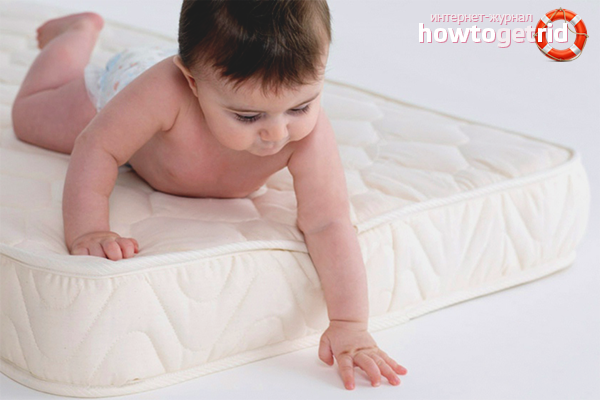
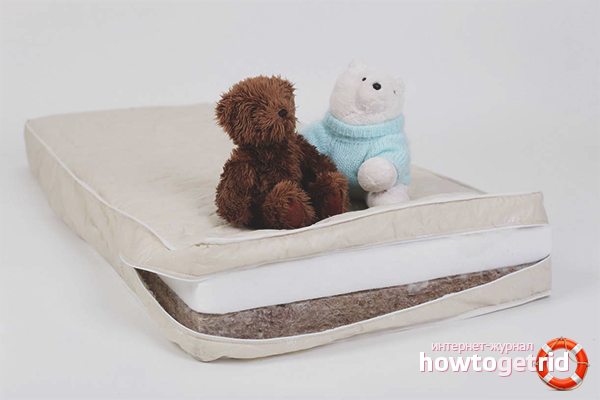

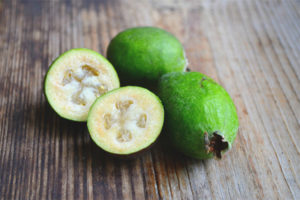
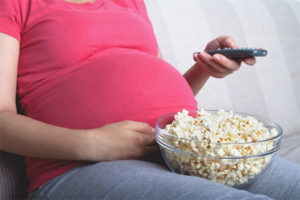


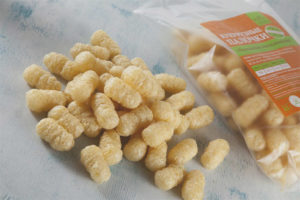
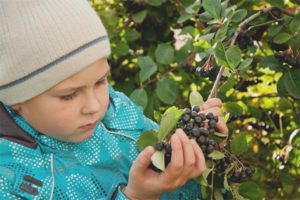


Submit